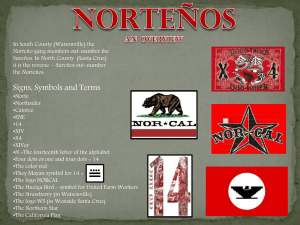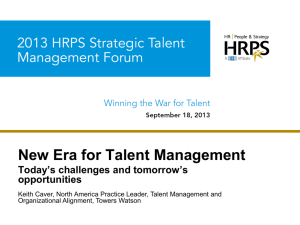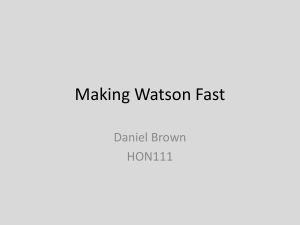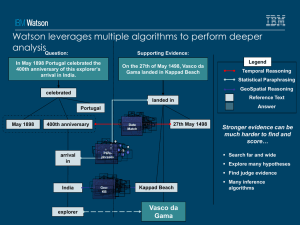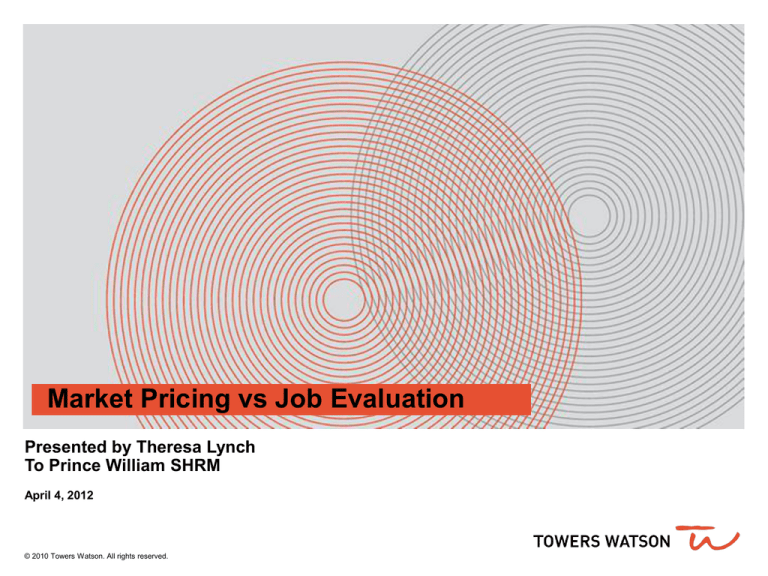
Market Pricing vs Job Evaluation
Presented by Theresa Lynch
To Prince William SHRM
April 4, 2012
© 2010 Towers Watson. All rights reserved.
Table of Contents
Introduction
Market Pricing Overview
Job Evaluation
The Intersection of Market Pricing and Job Evaluation
towerswatson.com
1
© 2010 Towers Watson. All rights reserved. Proprietary and Confidential. For Towers Watson and Towers Watson client use only.
Market Pricing Overview
towerswatson.com
2
© 2010 Towers Watson. All rights reserved. Proprietary and Confidential. For Towers Watson and Towers Watson client use only.
The critical role of market pricing
Compensation plays a critical role in organizations’ ongoing — and increasingly
challenging — efforts to attract, retain and motivate a talented workforce
It is an important component of an organization’s Reward, Talent and Engagement strategy
Compensation design and management play a vital role in aligning employee behavior with
business objectives
Human capital costs represent a significant part of most organizations’ cost bases; they
need to spend their limited resources as effectively as possible
Market pricing provides the vital external market perspective and data needed to develop
cost-effective, market-relevant compensation designs and manage pay effectively
Market pricing supports a range of pay program designs (base pay, short-term incentives
and long-term incentives)
Market pricing is the process of determining the "market rates" for a
representative sample of jobs in a specific talent market, based on data
for jobs with similar functions and comparable scope of responsibility.
towerswatson.com
3
© 2010 Towers Watson. All rights reserved. Proprietary and Confidential. For Towers Watson and Towers Watson client use only.
Market pricing overview
Market pricing provides information to support decisions about “how much” and
“how to” pay
The goal is to keep from:
Underpaying, and losing talent to competitors or being unable to attract the talent it
needs
Overpaying, and wasting organizational resources or impeding desirable turnover
Market pricing is a descriptive, not a prescriptive activity. Market data are not
“the answer” — there’s often more to the story
It’s an imperfect way to make sense of incomplete data
The secret is the ability to spot the imperfections and either eliminate them or work
around them
A combination of “art” and “science”
towerswatson.com
4
© 2010 Towers Watson. All rights reserved. Proprietary and Confidential. For Towers Watson and Towers Watson client use only.
Why do we market price?
Market pricing helps us understand the influence of supply and demand
on the cost of labor
Where is the market shifting, how quickly, and by how much?
How competitive is our pay? Are our attraction and retention issues a result
of pay or something else?
towerswatson.com
Talent Readily Available
Limited Available Talent
$
$$$$
Reduced Labor Cost
Increased Cost
5
© 2010 Towers Watson. All rights reserved. Proprietary and Confidential. For Towers Watson and Towers Watson client use only.
Why do we market price?
It provides us with data for informed decision making:
How should we allocate resources?
How do we value an acquisition target?
Is the way we deliver pay consistent with the mix other companies deliver?
How does the market reward employee development? Are we keeping up?
How well are we delivering against our compensation philosophy? Can we
afford to bridge gaps between where we are now and our target competitive
position?
What do market practices suggest for ongoing compensation management?
It’s essential to developing market-based reward programs
Based on detailed understanding of business and HR objectives
Anchored in a company’s HR strategy and compensation philosophy
towerswatson.com
6
© 2010 Towers Watson. All rights reserved. Proprietary and Confidential. For Towers Watson and Towers Watson client use only.
Market pricing: One of the many supporting elements of
all pay decisions
Performance Information
Informal/Formal
Individual/Team/Business
Unit/Organization
Compensation Information
External
Surveys and other analyses
Recruiting feedback
Trends and prospective
changes
Final Pay
Decision
Communicate
with Employee
Internal equity
Incumbent’s Current Pay Levels
towerswatson.com
7
© 2010 Towers Watson. All rights reserved. Proprietary and Confidential. For Towers Watson and Towers Watson client use only.
The limitations of market pricing
Numbers imply a precision that is not necessarily accurate
Only as valid as the salary survey data being referenced
Data not always available in sufficient detail — especially for narrowly
defined talent markets or small/developing countries
Published compensation surveys do not have every position, and often
do not include “hot skills” roles
Cannot provide insights into value of non-benchmark jobs
May cloud the organization’s judgment about taking internal equity into
account
Cannot be the only input for making individual pay decisions
Cannot replace business rationale and sound decision making
towerswatson.com
8
© 2010 Towers Watson. All rights reserved. Proprietary and Confidential. For Towers Watson and Towers Watson client use only.
Addressing non-benchmark positions
Each organization is unique, and the jobs in those organizations are
often also unique
In some organizations, as work becomes defined more broadly and where
job tasks may be combined in non-traditional ways, you may not be able to
find a “perfect” match for a job in any of your available salary surveys
Not all jobs will be able to be matched to survey data because they are:
Specific to an organization
Jobs for which survey data is not collected and/or reported
Do not force non-benchmark jobs to be benchmarks
Non-benchmark roles present an additional opportunity to discuss how to
manage pay
towerswatson.com
9
© 2010 Towers Watson. All rights reserved. Proprietary and Confidential. For Towers Watson and Towers Watson client use only.
Job Evaluation
towerswatson.com
10
© 2010 Towers Watson. All rights reserved. Proprietary and Confidential. For Towers Watson and Towers Watson client use only.
Job Leveling overview
Job leveling is…
A systematic process of determining the relative value of jobs in an
organization
A system for analysing and comparing different jobs according to the overall
responsibilities and scope of each job
It is not concerned with the volume of work, or with the person doing it, or
with current pay
Purpose
Establish a framework for:
— Defining jobs and hierarchy
— Providing a foundation for reward and talent management decisions including base
pay, incentives, career management, workforce planning, learning and
development
— Creating a flexible, adaptable means of communicating career paths and facilitating
talent mobility
Goal
A consistent, internally relevant and market-supported approach that can be
understood by everyone involved
towerswatson.com
11
© 2010 Towers Watson. All rights reserved. Proprietary and Confidential. For Towers Watson and Towers Watson client use only.
Examples of Job Leveling Solutions
Reflect different methods of analyzing jobs
Job Mapping:
Job Evaluation:
Comparing a job against predefined leveling criteria, and
assigning the job to a career
level based on a holistic view
of how the job is expected to
contribute (Career Map)
Analyzing a job against a
number of factors where each
factor is measured separately
and the resulting evaluation is
based on a calculation of the
weighted factor scores (GGS)
VP
Management
Supv
Mgr
Sr Mgr
Grp Mgr
Sr Grp Mgr
SVP
EVP
FUNCTIONAL STRATEGY
5FS
LEADERSHIP
4M
BUSINESS STRATEGY
5BS
BAND
CEO
GRADE
1
2
3
4
5
6
7
8
1
0
9
MANAGEMENT
CAREER PATH
Management Role
Executive
EXPERTISE
3M
1
1
1
2
1
3
1
4
1
5
1
6
1
7
1
8
1
9
2
0
CEO
'ROLE' CONTRIBUTES (THROUGH)
SKILLS
2
TASKS
1
2
1
2
2
2
3
2
4
2
5
2
1
2
2
2
3
2
4
2
5
1st. LINE
TOP MANAGEMENT
TOP
MANAGEMENT
MIDDLE
MANAGEMENT
SUPERVISOR
Professional/Expert
Intermed
Business Support
Entry
Intermed
Senior
Production
Entry
Intermed
towerswatson.com
Senior
Lead
Lead
Supv
Career
Specialist
Master
1
Expert
INDIVIDUAL CONTRIBUTOR
CAREER PATH
Individual Contributor Role
Entry
1
2
2
3
4
5
6
3IC
7
8
1
0
9
4IC
1
1
1
2
1
3
1
4
1
5
1
6
1
7
1
8
1
9
2
0
SUBJECT MATTER
EXPERT
PROFESSIONAL
TECHNICIAN
CLERICAL / ADMINISTRATIVE
MANUAL
12
© 2010 Towers Watson. All rights reserved. Proprietary and Confidential. For Towers Watson and Towers Watson client use only.
Job Leveling Solutions
Aligning tools to support the rewards and career framework
The best job leveling approach will vary based on:
Business and cultural needs and
The reward and talent management programs the leveling outcomes are
intended to support
Key questions for consideration:
What is the primary objective of the job leveling process?
— Create or confirm job family architecture?
— Support compensation design?
— Link to performance management or additional talent management programs?
— Desired degree of transparency of leveling outcomes
What process is envisioned for leveling jobs; who will be involved?
What is the organizational context of the business?
towerswatson.com
13
© 2010 Towers Watson. All rights reserved. Proprietary and Confidential. For Towers Watson and Towers Watson client use only.
DRAFT
Towers Watson’s Reward and Career Framework
Supporting the Employee Life Cycle
Workforce Analytics
& Planning
Staffing & Selection
Development and
Career
Management
Performance
Management
Compensation &
Benefits
Succession
Management
Competency Model
Reward and Career Architecture
Job Leveling
A systematic process of determining the
relative value of jobs in an organization
Job Family Architecture
The infrastructure for organizing jobs
(job codes, job titles, functions, disciplines)
Inputs
Business Context
towerswatson.com
Reward and
Talent Strategy
Job Content
Employee Data
Market Data
14
© 2010 Towers Watson. All rights reserved. Proprietary and Confidential. For Towers Watson and Towers Watson client use only.
The Intersection of Market Pricing and Job
Evaluation
towerswatson.com
15
© 2010 Towers Watson. All rights reserved. Proprietary and Confidential. For Towers Watson and Towers Watson client use only.
The critical role of salary structures
Salary structures help organizations manage compensation by aligning pay
with the competitive marketplace, recognizing the relative internal value of
different jobs, and maintaining the cost-effectiveness of pay programs
They provide a framework for rewarding performance, making consistent pay
decisions, and linking career paths and pay opportunities, and can provide a
framework for total rewards design and delivery
Salary structures are sets of pay ranges that define the minimum and
maximum pay rates for jobs. They provide guidance to managers in
administering pay, recruiting and retaining employees, and fostering
employee growth and development
towerswatson.com
16
© 2010 Towers Watson. All rights reserved. Proprietary and Confidential. For Towers Watson and Towers Watson client use only.
Salary Structure Design:
Historical Perspective on Market Practice
Narrow grade structures are the most traditional, reflecting a historical emphasis on
employees as inputs and costs, as opposed to strategic assets (personnel vs. human
capital)
Broad-band structures became popular in the early 1990’s
Existing grade hierarchies no longer reflected flatter organizations that resulted from down-sizing
activities
Work became more broadly defined – careers were perceived to grow laterally through experience
and cross-functional experience
Broad-bands were seen as a tool to ensure talent mobility across functions
Increasing demand for labor brought a greater focus on pure market pricing and
deemphasized the need for talent mobility, requiring:
Administrative rigor – stringent market analysis and credible market info
Ongoing manager training to effectively use the ranges, pure market data and reference points
Today the focus is increasingly on achieving balance to support:
Internal consistency, employee development and external competitiveness
Differentiated pay for performance, manager flexibility and overall cost management tools
As a result, many organizations have adopted wide grade structures to better balance
changing organizational structures, evolving views of human resources, and the
continued need to manage costs
towerswatson.com
17
© 2010 Towers Watson. All rights reserved. Proprietary and Confidential. For Towers Watson and Towers Watson client use only.
A Reward and Career Architecture serves as a foundation
for critical talent and reward programs and applications
Employee Value Proposition
Workforce
Analytics and
Planning
Staffing and
Selection
Development &
Career
Management
Performance
Management
Compensation
& Benefits
Succession
Management
Reward and Career Architecture
towerswatson.com
18
© 2010 Towers Watson. All rights reserved. Proprietary and Confidential. For Towers Watson and Towers Watson client use only.
Integrated Reward and Career Framework:
Using Leveling Results to Develop a Global Salary Structure
Common
Leveling
Framework
Local Market
Data
$125,000 – $225,000
$180k
Local Market
Data
£125k
£95,000 – £150,000
$100,000 – $200,000
$155k
£102k
£85,000 – £125,000
$85,000 – $175,000
$120k
£85k
£60,000 – £100,000
£65k
£40,000 – £80,000
£22,000 – £52,000
Individual
Contributor
Manager
$60,000 – $115,000
$95k
$40,000 – $85,000
$60k
£35k
$35k
£15k
$25,000 – $50,000
towerswatson.com
£18,000 – £32,000
19
© 2010 Towers Watson. All rights reserved. Proprietary and Confidential. For Towers Watson and Towers Watson client use only.
Integrated Reward and Career Framework
Sample Pay Delivery Model
Management Role
Global Job Level
Executive
VP
SVP
EVP
CEO
Long-term
Incentive
Eligible
Management
Supv
Mgr
Sr Mgr
Grp Mgr
Sr Grp Mgr
Individual Contributor Role
Professional/Expert
Entry
Career
Specialist
Master
Annual
Incentive
Eligible
Expert
Business Support
Entry
Intermed
Senior
Lead
Supv
Spot Award
Eligible
Production
Entry
Salary Grade
Intermed
Intermed
Senior
Lead
Low
STI Target
LTI Target
towerswatson.com
High
10%
10%
10%
15%
20%
20%
25%
30%
40%
30%
35%
40%
50%
20
© 2010 Towers Watson. All rights reserved. Proprietary and Confidential. For Towers Watson and Towers Watson client use only.
Linking Competencies to the Reward and Career
Framework:
A robust structure to enable other talent programs and applications
Global Career Framework + Competencies
Management Career Path
Analytical Thinking — Applies processes of analysis and synthesis to examine information in a thorough and thoughtful way
Executive
VP
SVP
Professional/Expert
EVP
Entry
Intermediate
Career
Specialist
Master
Expert
Management
Supv
Mgr
Sr Mgr
Grp Mgr
Developing
Sr Grp Mgr
Individual Contributor Career Path
Professional/Expert
Entry
Intermed
Career
Specialist
Master
Expert
Intermed
Senior
Lead
Intermed
Senior
Collects basic information necessary to analyze a problem,
situation or issue
Performs routine or basic analysis, following the correct steps
and using the appropriate, established tools, observing and
seeking guidance from senior staff when necessary
Supv
Production
Entry
Supporting
Identifies basic implications/conclusions from the logical
analysis of a routine situation or issue
Business Support
Entry
Lead
Global Career Framework
Uses career bands (e.g., professional,
manager) and career levels (e.g. entry,
intermediate) to organize and align roles across
the organization
Scaled competencies, aligned with each level of the career framework,
describe the behavioral requirements associated with the job
+
Logically synthesizes
information to uncover
patterns, issues, errors and
potential implications
Breaks down information
from multiple sources to
analyze a problem, situation
or issue from a variety of
perspectives
Leverages methods and
approaches for data
collection from other
internal/external sources
and best practices to
address problems,
situations or issues
Applying
Extrapolates from past
experience and facilitates
input from others to
determine probable
outcomes
Recognizes and anticipates
areas where data may be
missing or incomplete and
collects all necessary
information to analyze a
complex problem, situation
or issue
Leading
Uses advanced tools to
integrate and assess
complex data or information
and models effective data
synthesis and analysis skills
so that others can learn
them
Maintains a broad
perspective to identify
interdependencies and
relevance of information to
uncover subtle or hidden
implications and risks
Shaping
Guides others in analytical
thinking skills, data
gathering and logical
analysis
Standardizes methods and
tools for analyzing complex
problems, situations or
issues and discerning
patterns within the business
context
Sees relationships in
seemingly unrelated data to
identify unlikely root causes
and potential implications in
complex situations
Challenges all to think
creatively about
approaches and
conclusions when
collecting, analyzing and
organizing relevant data
Encourages and rewards
development of
breakthrough methods or
tools for analyzing complex
problems, situations or
issues and discerning
patterns within the business
context
Competencies
Clarifies the knowledge, skills and abilities
required for successful performance
Supports link to performance management,
career development, succession planning
Includes criteria to clearly describe each career
level
towerswatson.com
21
© 2010 Towers Watson. All rights reserved. Proprietary and Confidential. For Towers Watson and Towers Watson client use only.
Questions?
towerswatson.com
22
© 2010 Towers Watson. All rights reserved. Proprietary and Confidential. For Towers Watson and Towers Watson client use only.

